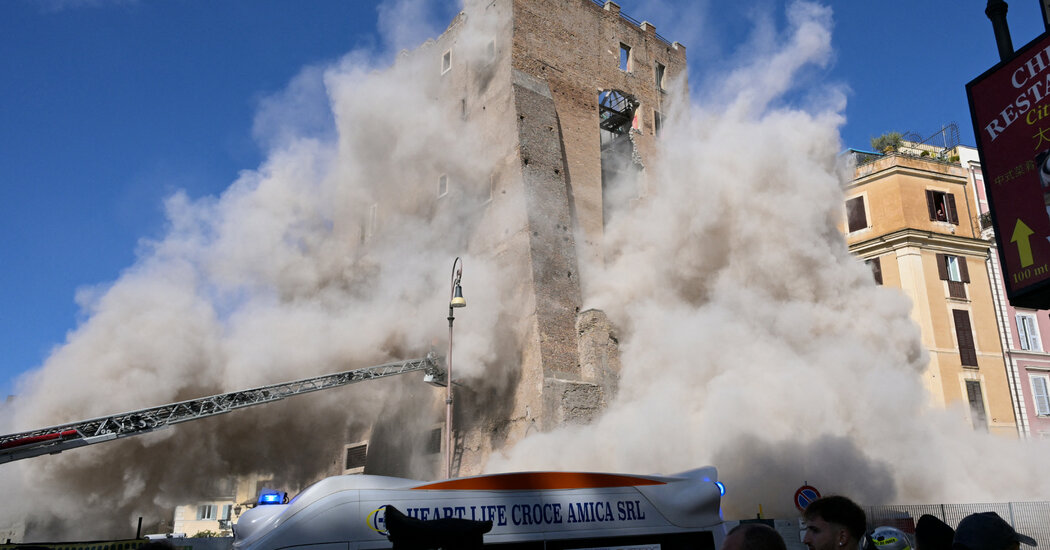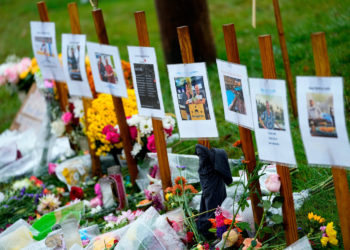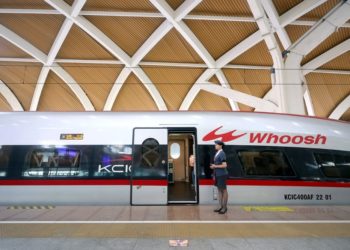The Torre dei Conti, a medieval tower near Rome’s famed Colosseum, partially collapsed on Monday, seriously injuring a worker and trapping another inside, Italian officials said.
After nearly 11 hours, emergency workers were able to extract the man who had been trapped by the rubble, but he died soon after arriving at the hospital, Italian media reported.
Rescue operations proved to be difficult because the structure was unstable and was a safety risk for rescuers, said Luca Cari, a spokesman for Italy’s firefighters.
Mr. Cari said that some 140 firefighters had been involved in the rescue, which required removing debris and rubble that had fallen inside the tower when it collapsed so that the worker could be reached.
Rome’s mayor, Roberto Gualtieri, praised the rescue workers for having placed their own lives at risk to try to save the man, who was officially identified only as a Romanian worker.
Earlier in the day, three workers had been rescued by a fire department ladder truck, after parts of one wall of the tower collapsed before noon. One was admitted to hospital and two sustained minor injuries, according to officials.
A second partial collapse occurred as firefighters were completing the rescue operation. The Romanian worker was trapped by that second collapse, Mr. Cari said.
The group was part of a team conducting restoration work on the tower, which had been used in modern times for municipal offices until 2006. The medieval tower had fallen into a state of “total abandonment” in recent years, and nearly 7 million euros, or roughly $8 million, has been allocated for its restoration, according to a municipal website. European Union funds had been set aside for the project, a Rome city official said.
The first phase of the structure’s restoration had begun in June, according to a statement by Rome municipal art authorities. It involved the removal of asbestos and preliminary work.
The first collapse Monday affected the central buttress on the southern side of the tower, which caused part of the base to collapse. The second collapse affected part of the stairwell and the roof, according to the statement.
The tower’s restoration, which was being done by two companies, included structural reinforcement as part of a general refurbishment. Once completed, the tower was to become a service center for the adjacent archaeological area.
Before the work began, “structural surveys, load tests and core sampling were carried out to verify the static suitability of the structure, which confirmed the necessary safety conditions to proceed with the work on the floors,” the statement said.
The tower, which stands nearly 100 feet tall and is near the Roman Forum and the Colosseum, was used by Pope Innocent III as a residence for his family in the 13th century. It has undergone various structural and cosmetic changes over the centuries.
The tower is a “perfect example” of the fortified residences built by aristocrats and high-ranking clerics during Middle Ages, according to Rome’s tourism website. Its base was constructed on the ruins of the Temple of Peace, built in the first century, in the Roman Forum.
It is also about a third of its original height. The upper floors were destroyed “by a series of earthquakes, especially those of 1348, 1630 and 1644,” according to the website, and the damage prompted significant restoration in the 17th century.
The tower was tentatively scheduled to reopen in 2026 after a four-year restoration project.
After the collapse on Monday, police barricades blocked off the streets leading to the tower, which is at the crossroads of a street that leads from the Colosseum to the central Piazza Venezia. Emergency vehicles and several fire trucks surrounded the base of the tower, and by midafternoon, several trucks had arrived to help remove rubble from the site.
About six hours after the collapse, specialized firefighters positioned an enormous hose through a window about 30 feet from the ground and began extracting rubble from inside the building, near where the worker was trapped.
As night fell, floodlights were brought in so that the rescue effort could continue. Firefighters spent more than five hours extracting rubble, at times using their hands to throw out larger slabs of building material. Eleven hours after the collapse, he was brought out, but his condition had been serious, Rome prefect Lamberto Giannini had told reporters at the site.
Elisabetta Povoledo is a Times reporter based in Rome, covering Italy, the Vatican and the culture of the region. She has been a journalist for 35 years.
Ali Watkins covers international news for The Times and is based in Belfast.
The post Medieval Tower in Rome Partially Collapses, Trapping Worker Who Died After Rescue Efforts appeared first on New York Times.




